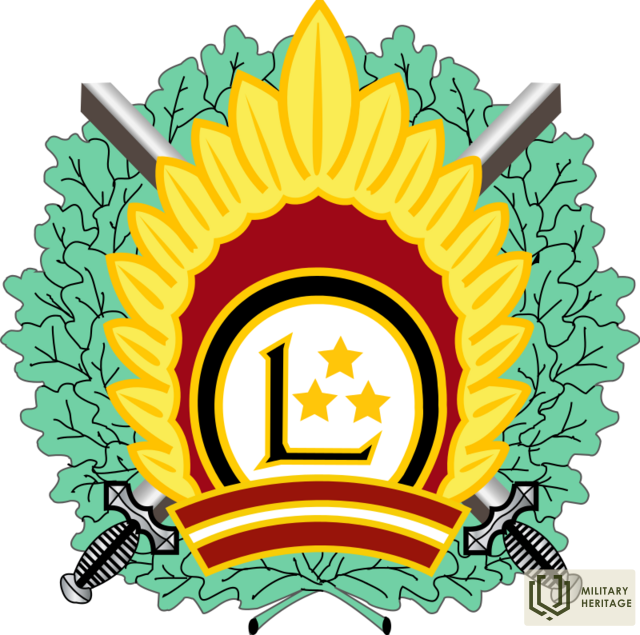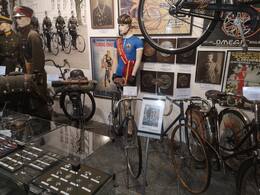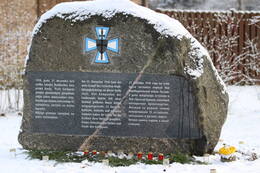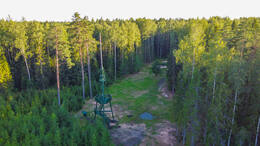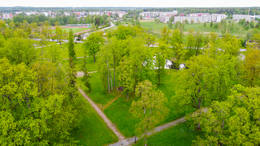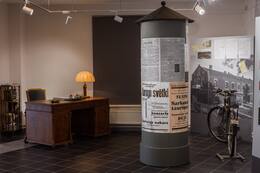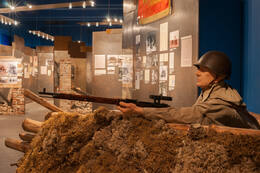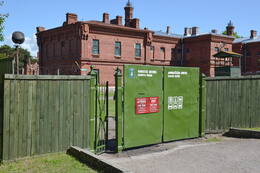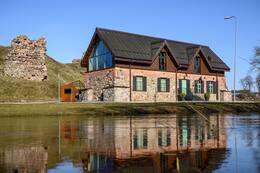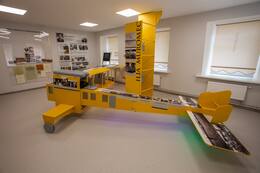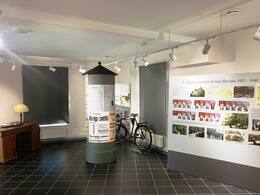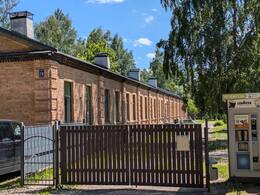Läti armee
I Maailmasõda ja iseseisvumine, Independence of the Baltic States, II Maailmasõda
Am 5. Januar 1919 wurde die erste größte nationale Militäreinheit gegründet - das separate lettische Bataillon unter dem Kommando von Oberstleutnant Oskars Kalpaks. Diese Einheit, die im März in eine Brigade umgewandelt wurde, bildete zusammen mit der in Estland organisierten und von Oberst Jorgis Zemitans kommandierten nordlettischen Brigade die lettische Armee. Die neu aufgestellte Armee wuchs und festigte sich in den Kämpfen gegen die Bermontianer bei Riga und Kurzeme sowie in den Kämpfen gegen die Bolschewiki an der Front in Latgale.
Eine Woche nach dem Ende des Ersten Weltkriegs und dem Abschluss des Waffenstillstands von Compjena am 11. November 1918 wurde die Gründung eines unabhängigen lettischen Staates proklamiert. Die neue Übergangsregierung hatte gehofft, auf eine reguläre Armee verzichten zu können, da niemand angreifen würde. Am 13. November 1918 widerrief Sowjetrußland den Brestlitow-Friedensvertrag, der zugunsten Deutschlands auf das baltische Territorium verzichtet hatte, und begann, nach Westen zu ziehen. Erwartungen, dass die deutsche Armee ihre Verpflichtung zur Verteidigung Lettlands gegen die bolschewistische Invasion erfüllen würde, erfüllten sich nicht.
In der Zwischenzeit wurden in Riga Truppen aufgestellt, die der Provisorischen Regierung der Republik Lettland treu ergeben waren. Im Frühjahr 1919 bestand die lettische Armee aus der Landeswehr (Deutsch-Baltische Nationalgarde), der Nordlettischen Brigade und der Südlettischen Brigade. Am 10. Juli 1919 vereinte General Dāvis Sīmansons die beiden Brigaden und wurde der erste Oberbefehlshaber der lettischen Armee. Dieser Tag gilt als der Tag, an dem die lettische Armee gegründet wurde.
1919 wurde die lettische Armee schnell bewaffnet und entwickelt, und Waffen und Ausrüstung wurden aus England, Polen und anderen Ländern geliefert. Anfang 1920 dienten etwa 52.000 Soldaten in den lettischen Streitkräften. Der Unabhängigkeitskrieg endete am 11. August 1920, als ein Friedensvertrag mit Sowjetrussland unterzeichnet wurde. Unmittelbar nach dem Unabhängigkeitskrieg begann die lettische Armee, in einen Friedensstaat überzugehen. Die lettische Armee bestand aus vier Infanteriedivisionen mit jeweils drei Infanterieregimentern und einem Artillerieregiment. Die Infanterieregimenter wurden nummeriert und nach lettischen Städten benannt. Die lettische Armee hatte auch eine Marine, bestehend aus dem Flaggschiff Virsaitis, einer U-Boot-Division mit zwei U-Booten „Ronis“ und „Spidola“, sowie einer Minendivision mit zwei Minensuchbooten „Imanta“ und „Viesturs“ und mehreren Unterstützungsschiffen.
Die Zusammensetzung der Armee wurde auf der Grundlage des allgemeinen Militärdienstes gebildet, dem alle lettischen Bürger unterworfen waren. Bis 1931 betrug die Dienstzeit 18 Monate, später wurde sie für Infanterie auf 12 Monate verkürzt, für andere Waffenklassen auf 15 Monate. Armee und Marine wurden vom Kriegsministerium verwaltet. Der Armeekommandant war verantwortlich für die Armee, die für die Ausbildung und Vorbereitung der Armee verantwortlich war.
Am 1. Juni 1940 zählte die lettische Armee 30.843 Mann. Am 17. Juni 1940, während des Zweiten Weltkriegs, übernahmen sowjetische Truppen die Kontrolle über ganz Lettland und Estland. Die lettische Armee wurde nach und nach aufgelöst, zog sich in Reserve zurück, verhaftete und deportierte lettische Soldaten. Am 27. September 1940 wurde die Position des lettischen Kriegsministers abgeschafft, aber am 9. Oktober 1940 wurde die Position des Kommandeurs der lettischen Volksarmee abgeschafft.
Am 17. Juni 1989 fand die Gründungskonferenz des Lettischen Schützenverbandes in der Großen Halle der Staatlichen Universität von Lettland in Riga statt. Danach traten innerhalb weniger Wochen mehr als 500 ehemalige Soldaten dem lettischen Schützenverband bei. Im Herbst wurden Zweige und Gruppen in Jelgava, Tukums, Liepaja, Bauska, Balvi, Livani, Moskau und anderswo gegründet. Die aktive Arbeit an der Schaffung und Entwicklung von Gesetzen, Vorschriften und verschiedenen Dokumenten, die für die Gründung und Existenz der Armee erforderlich sind, beginnt.
Am 10. September 1991 wurde ein Gesetz über die Wehrpflicht verabschiedet. Aufgrund dieses Gesetzes müssen alle männlichen Bürger Lettlands im Alter von 19 bis 50 Jahren den Wehrdienst leisten. Kurz nach der Verabschiedung dieses Gesetzes, am 11. November, wird auf dem Brüderfriedhof der erste Soldateneid seit der Wiederherstellung der lettischen Unabhängigkeit abgelegt.
Rohkem teabeallikaid
1. 100 Ereignisse in der Geschichte Lettlands. Menschen und Prozesse 1918-2018. JSC „Latvijas Mediji“, 2018.
2. Der Schneesturm der Seelen. Digitales Museum. Verfügbar: https://www.dveseluputenis.lv/lv/laika-skala/notikums/105/sarkanas-armijas-iebrukums-latvija/ [Zugriff: 08.05.2021].
3. Website der Nationalen Streitkräfte. Verfügbar: https://www.mil.lv/lv/par-mums/vesture [aufgerufen am 08.05.202
Related objects
Sõjaväejalgrataste väljapanek Saulkrasti Jalgrattamuuseumis
Jalgrattamuuseum asub Saulkrastis Valge luite (Baltā kāpa), maantee A1 ja Pabaži raudteejaama läheduses. Muuseumikogu koosneb tehniliselt kõige põnevamatest Läti jalgrattaajaloo näidetest. See on Baltimaade suurim jalgrattakollektsioon, kuhu kuulub umbes 60 Lätis valmistatud ja kasutusel olnud jalgratast, sealhulgas sõjaväe näidisrattad. 20. sajandi alguses hakati sõjavägedes laialt kasutama jalgrattaid tänu nende kättesaadavusele ja eelistele. Moodustati spetsiaalseid ratturite üksuseid, mis suutsid kiiresti liikuda. Ratturid suutsid kergemini luureandmeid koguda, korraldada ootamatuid rünnakuid vaenlase vastu ning tegutsesid suurel maa-alal jalaväest osavamalt. Pärast Esimest maailmasõda olid ka Läti armees ratturite üksused, mis kasutasid Lätis toodetud sõjaväejalgrattaid. Ratturite üksusesse kuuluv sõdur pidi vastama rangetele nõuetele. Ta pidi olema vastupidav, hea nägemise ja kuulmisega ning tema süda ja kopsud pidid olema terved. Ta ei tohtinud kaaluda alla 80 kg ning pidi olema 165–180 cm pikk. Läti sõjaväes oli kindlaks määratud, et hea ettevalmistuse saanud rattur pidi päevas läbima 80–100 km ja kui olukord nõudis, siis ka 150 km. Talvel, kui jalgratast kasutada ei saanud, sõideti suuskadel. Rattur pidi päevas suutma suusatada 50–60 km. Paljudest sõjaväe ratturitest said professionaalsed sportlased.
Esimese Läti iseseisvuslahingu monument
Atroadas, Inčukalns, Atmodase tänav 2.
3. juulil 2016 avati Läti rahvuskaardile (Die Lettländische Landeswehr) pühendatud mälestussammas esimesele lahingule Läti iseseisvuse eest. küljed. Vendade kalmistukomitee esimees Eižens Upmanis jõudis toona järeldusele, et tegemist võib olla ajalooliselt esimese mälestusmärgiga Läti ja Balti ühendvägedele väljaspool kalmistut asuvates lahingute mälestusmärkides. Sel ajal määrati Läti rahvuskaardi ehk Landesveri Läti üksuste ülemaks kolonelleitnant Oskars Kalpaks, kelle üksustest kasvas välja ja kujunes vabadusvõitluste käigus välja hilisem Läti sõjavägi.
1918. aastal oli kogu praeguse Läti territoorium langenud Saksa keisririigi ja selle vägede kätte. 1918. aasta suve lõpus ja sügisel hakkas olukord Saksamaa jaoks aga halvasti lõppema ning oli selge, et on vaid aja küsimus, millal Saksamaa on sunnitud tunnistama kaotust I maailmasõjas. Vene impeerium, mille koosseisu kuulus ka Läti enne I maailmasõda, oli lakanud eksisteerimast varem, 1917. aasta veebruari- ja oktoobrirevolutsioonidega. 18. novembril 1918 kuulutati välja Läti Vabariik. Pärast relvarahu Antantiga 11. novembril 1918 ei olnud Läti territooriumil olnud Saksa armeel enam motivatsiooni edasiseks sõjapidamiseks ning enamik selle sõdureid soovis lihtsalt koju tagasi pöörduda.
Sellistes oludes oli selge, et Läti kaitse sõltus eelkõige Läti rahva moodustatud rahvuskaardist. Esialgu näitasid oma hariduse ja suhteliselt suurema iseorganiseerumisvõime tõttu suurimat initsiatiivi sellise rahvuskaardi loomisel Lätis elavad baltisakslased. Vene sõdurid liitusid ka rahvuskaardiga. Rahvuskaardi varustamise tagamiseks vormiriietuse, relvade ja muude vajalike vahenditega sõlmis Läti Ajutine Valitsus 7. detsembril 1918 Saksa esindaja August Vinnigiga lepingu, mis nägi ette Rahvuskaardi varustamist alates 2018. a. Saksa armee reservid Lätis. Selles lepingus oli muu hulgas kirjas, et rahvuskaart, ametlikult tuntud kui Läti rahvuskaart või saksa keeles die Lettländische Landeswehr, on Läti Vabariigi relvajõud.
Läti rahvuskaardiga astusid vastamisi kaks Läti punase laskurrügemendi sõdurit (ehk ligikaudu 2000–3000 sõdurit), kes olid varem kogenud I maailmasõda ja Venemaa kodusõda. Vaatamata Punaarmee kogemustele ja arvulisele ülekaalule hoidis Läti rahvuskaart Inčukalnsit kaks päeva ägedates võitlustes, kuni lõpuks, 1. jaanuari õhtul 1919, sunniti piiramise vältimiseks erru minema, kaotades 43 hukkunut ja mitu. haavatud, kellest enamik võeti bolševike vangi, kus nad tapeti või surid nälga või haigustesse.
Autor: Artis Buks. Materjal: rahn. Monument on valmistatud suurest monoliitsest kivist, mis leiti Jelgava lähedalt Rollsist.
Läti sõjaväe suvelaagriplats Litenes
Läti sõjaväe Litene suvine laagriplats asub Litene vallas Pededze jõe äärses metsakohas. Litene laagri algusaeg ulatub 1935. aastasse, mil Läti sõjaväe Latgale diviis hakkas siia rajama suvelaagripaika. Maikuust sügiseni harjutasid mitu tuhat sõdurit Litenes lahingutaktikaid ja laskmist. 1941. aasta suvel arreteerisid Punaarmee ja NKVD väed Litene suvelaagris olevad Läti armee ohvitserid. Mitu ohvitseri lasti kohapeal maha, ülejäänud küüditati Siberisse. 14. juunil 1941 arreteeriti ja küüditati Litene ja Ostrovieši laagrist (see asub u 10 km kaugusel Litenest) vähemalt 430 ohvitseri. Ainus ajalooline hoone, mis on laagriajast säilinud, on toiduladu. Teistest hoonetest on säilinud vaid vundamendid. Laagrialale on rajatud vaateplatvorm, kus lehvib Läti lipp, on sisse seatud pingid ja heakorrastatud lõkkekoht. Kaitseministeeriumi ja Riiklike Relvajõudude toetusel on siia paigaldatud suurtükk. Olemas on infotahvlid. Litene laagri sündmustega on seotud mälestuspaik Litene kalmistul – memoriaalansambel „Valumüür”. Läti armee YouTube’i kanalilt võib vaadata videot pealkirjaga „Litene, Läti armee Katõn”.
Latvian military aviation aerodrome
Located in the territory of Vecgulbene manor - in the historical center.
In the interwar period, the garrison of the Latvian Army was located in Gulbene, where the 7th Sigulda Infantry Regiment Battalion was stationed. Aerodromes are especially important in places where important railway and road junctions have been established. In 1937, a newly established unit of the Aviation Regiment was stationed in Gulbene, which became the 6th Division of the Latgale Division Scouts, increasing the number of army units near the eastern border of Latvia.
The conservatory building is visible.
Exposition "Latvian Army in Pļaviņas in the 20th Century"
Located at Odzienas Street 2, Pļaviņas.
The permanent exposition "Latvian Army in Pļaviņas in the 20th Century" can be seen.
The building in Pļaviņas, Odzienas Street 2, has a long history - from the time when Stukmaņi wholesaler Hugo Apeltofts started active economic activity in it, thus promoting the development of Pļaviņas city, until the headquarters of the Latvian Eastern Front was established here during the War of Independence. In 1919, the activities of Latvian army units against the Red Army in Latgale were commanded directly from Pļaviņas.
In 1934, a memorial plaque was unveiled near this house with the inscription: "In 1919, the headquarters of the Eastern Front was located in this house, and here General Jānis Balodis took over the command of the Latvian National Army." It was removed and destroyed by the Soviets in 1940, but on June 16, 1990, with the support of the LNNK Plavinas branch, it was restored.
Now, next to the former headquarters building, there is a memorial stall dedicated to 15 cavalry of the Lāčplēsis Military Order born in Pļaviņas region. In Pļaviņas, as well as provides an insight into the life stories of the Knights of the Lāčplēsis War Order.
Not far from the exposition building is the Latgale Division headquarters building, which was built in 1913 by Count Teodors Medems as a Stukmaņi liqueur factory. In 1919 it was taken over by the regime of P. Stučka, where it had also established a prison. After the expulsion of the Bolsheviks, in 1925 the building was taken over by the Latvian Army, which housed the headquarters of the Latgale Division. 10 generals and other officers of the Latvian Army spent their military careers in this building. In 1940, the building was taken over by the Red Army. In the post-war years, it housed a school as well as a municipality. Around 1970, the building was started to be used by the production association "Rīgas Apīrsbs".
Visits to the exhibition must be booked in advance by calling T. 28442692.
Memorial Wall of Pain
Artrodas Litene cemetery.
On June 14, 2001, the memorial “Wall of Pain” created by architects Dina Grūbe, Benita and Dainis Bērziņš, stonemasons Ivars Feldbergs and Sandra Skribnovskis was unveiled in Litene Cemetery, it symbolizes the resting place of the soldiers killed in 1941. In October 1988, the ashes of 11 officers killed in June 1941 by the Soviet Army were found in the territory of the former Latvian Army summer camp in Sita Silila, Litene Parish. Although they could not be identified, on December 2, 1989, at the consecration service in Gulbene Evangelical Lutheran Church, Litene Cemetery was solemnly reburied.
11 white crosses, memorial plaque and information stands.
Spilve airport
Located in Riga, Pardaugava, Spilve meadows near Ilguciems.
Spilve is famous in the history of military heritage for the large-scale battle of Spilve in the 18th century. and Spilve Airport. Beginning in the 20th century, it was used to test aircraft, but in World War I it became a witness to the history of Latvian aviation.
In World War I, Spilve meadows were used for the needs of the Russian Air Force in the fight against the German Army. With the establishment of Latvia, the airfield became the most important base of the national air force and a place for pilot training. The previous names of the airport were "Spilve Airport" or "Riga Airport", later "Riga Central Airport". It was the main airport in Latvia until the opening of Riga Airport in 1975.
It is possible that Spilve Airport near Riga and the dream of reaching for the stars have contributed to the impressive achievements of many Latvian pilots. Perhaps, however, the beginning of Latvian aviation is much older and can be found in Priekule, where a Latvian blacksmith Zviedris made a flight from the church tower with a homemade device.
Today, Spilve Airport is still open. You can see the airport building built in 1954, which embodies the style of Soviet classicism or "Stalin's Empire".
Sources:
Irbītis, K. Latvian Aviation and Its Pioneers. Riga: Science, 2004.
Brūvelis, E. History of Latvian Aviation: 1919-1940. Riga: Science, 2003.
Official website of the State Agency "Civil Aviation Agency". Available: https://www.caa.gov.lv/lv/latvijas-aviacijas-vesture-isuma [accessed 22.02.2021].
Latvian War Museum
The Latvian War Museum is located in the Old Town not far from the Freedom Monument in a historic defence building called the ‘Powder Tower’. There are 11 exhibits in the museum. There are various weapons, documents, uniforms, awards, badges and other items detailing the everyday life of a soldier in war. The Latvian War Museum is one of the oldest museums in Latvia. Its origins can be found in World War I. Museum’s collection was made up mainly of personal items of soldiers or items found on battlefields. After Latvia gained its independence the main goal of the museum became to create an exposition on the military history of Latvia and the active role of the population in protecting their land. In 1937 the museum was expanded and was technically one of the most modern museums in Europe at that time. The Powder Tower was one of the fortification towers of Riga. Some evidence dates back to 1330 where it has been mentioned as the ‘Sand Tower’. The tower was destroyed in 1621 when Riga was besieged by the Swedish Army. But in 1650 a new tower for storing gunpowder and weapons was built. After the city’s fortifications were taken down, the Powder Tower remains as one of the most important pieces of evidence of the Riga defence system.
Karosta Military Prison
The Karosta Prison in Liepāja is the only military prison in Europe open to tourists. Constructed around 1900 for the needs of a hospital, the building was never used for its original purpose. The structure was repurposed as a place for serving temporary disciplinary punishment and was used as such up until 1997.
Powers changed but the purpose of the institution remained the same, namely, to house prisoners, including revolutionaries, sailors and non-commissioned officers of the Russian tsarist army, German deserters, enemies of the people of the Stalin era, as well as soldiers of the Soviet and Latvian armies. The Karosta Prison is currently open to visitors and guided tours are available. The tours show the prison and visitors can learn about its history, have a look at the prison and punishment cells and hear interesting and even ghostly tales about life at the prison. Braver souls have the opportunity to play the ‘Behind the Bars’ reality game or try to get out of closed rooms. And those who know no fear can spend the night in a prison cell. The Karosta Prison has a Karosta Visitor Centre, a Soviet-era buffet and a souvenir shop. The services of a guide are available throughout the whole of Karosta.
Treasure House of the Free State
A unique exposition on the history of military and civil awards of the first free state of Latvia, as well as various organizations related to the activities of state and civil organizations in the period from the Latvian War of Independence to the Second World War.
Several hundred different historical evidences from Latvian and foreign private collections are exhibited in the exhibition house, covering the period from 1918 to 1940, revealing the pages of the history of Latgale and Rēzekne.
Preiļi Museum of History and Applied Arts exhibition "Jāzeps Baško - air coachman"
It is located in Preiļi 1st primary school premises.
The exhibition "Jāzeps Baško - air driver" was created in 2014 and is dedicated to the 125th birthday of the outstanding local man, aviator, commander of the "Iļja Muromec" squadron, organizer of the Latvian Air Force, general Jāzeps Baško and the 100th anniversary of World War I. The exhibition of the museum's collection is designed as a design object - a 6-fold reduced model of the "Ilya Muromec" airplane, on which information can be found in the form of texts and images. The exhibition is enriched by deposits from the collections of the Latvian War Museum and newly acquired information from the Latvian State History Archive, the Spilve Aviation Museum and materials from the private archives of individual individuals.
Mandatory prior application by calling T. 65322731, T. 25640398. Tour in English and Russian is possible. You can go to the exhibition "Jāzeps Baško - Air Driver" from the Museum of History and Applied Arts.
Exhibition "Latvian Army in Pļaviņas in the 20th Century"
The exhibition features information stands with historical photographs, maps, and information about the establishment of the Latvian Eastern Front Headquarters. The composition of the exhibition is made up of interior elements corresponding to historical events.
The exhibition “Latvian Army in Pļaviņas in the 20th Century” is located in Pļaviņas, Odzienas Street 2, a historical building where the headquarters of the Latvian Eastern Front was located in July 1919 during the War of Independence. The two-story building has a rectangular layout with a gable roof, the building is built of red brick. Today, the second floor of the building has survived from the original facade, with visible window openings. Today, the facade of the first floor of the building has been plastered and painted, the ancient window openings have been expanded and the shop windows of the “Lats” store have been inserted. On the second floor, plastic windows have been installed in the window openings instead of the historical wooden windows.
The building has a long history – from the time when Stukmaņi wholesaler Hugo Apeltofts began active economic activities there, thus contributing to the development of the town of Pļaviņa.
In 1934, a memorial plaque was unveiled near this house with the inscription: “In 1919, the Eastern Front headquarters was located in this house, and here General Jānis Balodis assumed the supreme command of the Latvian National Army.” The Soviet government removed and destroyed it in 1940, but on June 16, 1990, with the support of the Pļaviņa branch of the Latvian National Liberation Army, it was restored.
Now, near the former headquarters building, there is a memorial stele dedicated to the 15 Cavaliers of the Lāčplēsis War Order born in the Pļaviņa region. After the Bolsheviks were driven out, the building was taken over by the Latvian Army in 1925, which housed the headquarters of the Latgale Division. 10 generals and other officers of the Latvian Army spent their military careers in this building. In 1940, the building was taken over by the Red Army. In the post-war years, it housed a school, as well as the municipality. Around 1970, the building began to be used by the production association “Rīgas Apērbs”.
Visiting the exhibition must be booked in advance by calling Tel. +371 28442692.
Latgale Artillery Regiment Army Barracks
The Latgale Artillery Regiment Army Barracks were built as a three-story modern building according to the project of architect Verners Vitands in 1931. This monolithic reinforced concrete building was one of the first in Latvia. They have survived, located in the territory of the Krustpils Manor, next to the castle park. Today, the three-story building that has survived is the unmanaged property of the Jēkabpils municipality. Window openings without windows, entry into the building is not possible, the building can be viewed from the outside. The municipality has carried out roof replacement work. In the future, it is planned to renovate the building by placing various organizations there, and hand it over to entrepreneurs for use.
The Latgale Artillery Regiment consisted of two divisions, each division had two cannon and one howitzer battery, totaling 16 cannons and eight howitzers in the regiment. The remaining artillery units assigned to the regiment were stored in preserved warehouses and were intended for the formation of a third division in case of war.
Riga Garrison Army Tent Camp
Now there are bushes and thickets here, but in the thirties of the last century, the Riga garrison army summer camp was located here. In some places you can still see what look like rectangular ramparts. In these places there were soldiers' tents, arranged in four long rows, with small streets in the middle. At the ends of the rows stood the logos of the garrison units - they were cast from concrete, but the ornaments and inscriptions were made of small, colorful stones. The ramparts around the tents were necessary not only to retain moisture, but also for military purposes. If landing troops entered Mangaļsala, they would be used as trenches under the cover of which to protect the territory from the enemy. Although real military training was taking place here, a romantic idyll reigned in the air, which is also visible in photographs of the time. Young people played volleyball. In the courtyards of the officers' cottages, gazebos and flower beds were well-groomed. The soldiers were visited by their loved ones on weekends, bringing baskets of strawberries and fresh bread. Most meals were eaten outside at tables in the fresh air.
Army town
In this area, in the late 1920s and early 1930s, the Latvian army built an army camp for officers and soldiers who worked on Mangalsala. Later, the camp, along with the Mangalsala military base, became the property of the Soviet Union. Civilians without a certain status lived here, but later social apartments were created for low-income people. On the right side there was a football field and small gardens, but over time they turned into meadows and swamps. Later, private houses and a car service appeared here. Until the 1960s, Mangalsala was not part of Riga at all, but part of Mangali parish. At that time, people here were engaged in fishing or worked at the army base, because agriculture was practically impossible – the arable land area on Mangalsala is only 3.8%. Once upon a time, a narrow-gauge railway ran through the camp right along Mangalsala Street, but the street itself was paved. Now the pavement is hidden under a layer of asphalt. At the end of the road is the port area and the former military pier. Army ships were once moored there, and footbridges were built between them.
Can be seen from the outside, walking along Mangaļsalas Street.
Seotud lood
For the first Commander-in-Chief of the Latvian Army David Simanson
The essays of the book "Latvian Army Commanders" convince that history is significantly influenced by specific people. Although at the epicenter of the most important historical events for a short time, the true Latvian patriots, with their rich military experience, managed to accomplish a lot in the formation and strengthening of the Latvian army and the turn of historical events.
This story is about the first commander-in-chief of the Latvian army, David Simanson (1859-1933).
In memory of Pēteris Radziņš, General of the Latvian Army, two-time Knight of the Lāčplēsis War Order
General Pēteris Radziņš, born in Lugka Parish, Valka District, in a simple farmer's family, where he learned to do field work. He was a very smart young man, after graduating from school he decided in favor of the war and it started his army rescue of Latvia from Bermont's troops. P.Radziņš was one of the most outstanding officers of the Latvian Army and was awarded with numerous Latvian and foreign orders and memorials.
Army presence in Mangalsala
I remember vivid impressions about the presence of the Latvian army in Mangalsala. The forts as well as the reinforced concrete fortification built by Sapieri are described. Memories describe the daily life of soldiers, the rhythm of life and illustrate the environment in Mangalsala. Visit of soldiers of Mangalsala and Latvian army
Memories of the beginning of the establishment of the War Museum
The narrator describes the conditions under which the War Museum was established. Problems and collection work are mentioned.
United Aviation Festival - a real national holiday
The narrator describes one of the most popular and widely attended events in Latvia - the Aviation Festival in Spilve. Describes the course and scope of the festival. The popularity of aviation in Latvia is emphasized.
Par Sudrabkalniņa atklāšanas svētkiem
Atmiņu stāsta izvilkums no ģenerāļa Jāņa Baloža uzrunas Sudrabkalniņa pieminekļa atklāšanas dienā. Pilnā tekstā ir atstāsts par atklāšanas pasākuma norisi, Valsts prezidenta Kārļa Ulmaņa un ģenerāļa Jāņa Baloža uzrunas. Atmiņas izvēlētas, jo spilgti parāda to kādā stāvoklī bija Latvijas armija, kura cīnās Sudrabkalniņa apkaimē.
About Daugavgriva fortress
The narrator describes an event in the Daugavgrīva fortress during World War I, when it was bombed by an air force in the German army. The fortress was one of the strategic objects that remained important until the end of World War II.




